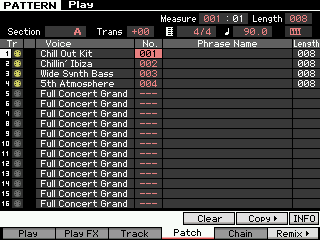What is a PATTERN Phrase and what is a PATTERN Patch?

Tagged Under
WHAT IS A PATTERN ‘PHRASE’ and WHAT IS A PATTERN ‘PATCH’? Any time you record something in PATTERN mode, the Motif XF sequencer will place that information on a track in an entity called a Phrase. So a Phrase is a group of MIDI events that can then be moved, recalled and edited as a unit. For example, say your record a drum kit to Track 1 – you use a Kick, snare, high hat closed, high hat open, and a crash cymbal. You record for 008 measures and then stop. The Motif XF sequencer will automatically number this recording and archive it as PHRASE 001. Press [F4] PATCH (shown at left). You can make a total of 256 individual recordings like this in a PATTERN. They can be drums, bass, guitars, etc., the instrument does not really matter. Any time you record in a PATTERN the data is placed in a PHRASE and given the lowest available number designation between 001 and 256. Why 256? Because there are 16 tracks in the sequencer and there are 16 Sections in Pattern mode [A] through [P]. 16×16 = 256 possible phrases per PATTERN number.
Any time you record something in PATTERN mode, the Motif XF sequencer will place that information on a track in an entity called a Phrase. So a Phrase is a group of MIDI events that can then be moved, recalled and edited as a unit. For example, say your record a drum kit to Track 1 – you use a Kick, snare, high hat closed, high hat open, and a crash cymbal. You record for 008 measures and then stop. The Motif XF sequencer will automatically number this recording and archive it as PHRASE 001. Press [F4] PATCH (shown at left). You can make a total of 256 individual recordings like this in a PATTERN. They can be drums, bass, guitars, etc., the instrument does not really matter. Any time you record in a PATTERN the data is placed in a PHRASE and given the lowest available number designation between 001 and 256. Why 256? Because there are 16 tracks in the sequencer and there are 16 Sections in Pattern mode [A] through [P]. 16×16 = 256 possible phrases per PATTERN number.
You can additionally name each phrase if you wish. Most people find that the number is sufficient. But if you are one of those people who like to keep things strictly organized, you can name each Phrase. This can be handy – because the PHRASE can be activated in any Section. Say you know that the basic groove you just recorded in SECTION “A” (your first verse), will be used again in the composition for the third verse (SECTION ‘C’)… different musical parts on top but the same drum groove. You do not have to COPY it, simply go to SECTION ‘C’ and activate PHRASE 001, on the PATCH screen. Phrases can be recalled simply by selecting them – very convenient. You select or “patch” phrases into Sections.
You can see that on TRACK 1 – the “Power Standard Kit” has been used to record Phrase number 001. To the right there is a blank space for you to name this phrase if you desire. The Length parameter on the far right is an indication of how many measures you have recorded. You cannot change the number of measures you have recorded here (without performing an edit “job”), however, you can control the number of measures that SECTION “A” plays back independent of the number of measures you have recorded… The LENGTH parameter on the top line (right corner) controls how many measures SECTION “A” is currently set to play. What does that mean? If in the shown example, where I have recorded 8 measures of each track 1, 2, 3 and 4, were I to change the LENGTH parameter in the top right corner to 3, the current Phrases would only play the first three measures:
1-2-3, 1-2-3, 1-2-3.
If I change the LENGTH to 7 they will only playback the first seven measures, and so on.
If I set it the LENGTH to 9, then they will play:
1-2-3-4-5-6-7-8-1, 1-2-3-4-5-6-7-8-1, 1-2-3-4-5-6-7-8-1 and so on.
Therefore you can think of that LENGTH parameter in the upper right corner as the SECTION LENGTH… the number of measures that will play before the Section repeats.
We mentioned that in order to change the LENGTH indicated in the far right column of each Phrase you must perform an EDIT Job. There are several ways to lengthen or shorten a phrase after you have recorded it.
• JOB: Append Phrase to lengthen it – this allows you to copy one phrase to the end of another or to the end of itself.
• JOB: Split Phrase to shorten it – this allows you to divide a phrase into two separate phrases or you can simply send the second portion to OFF (to make it go away).
You can think of the LENGTH parameter on the right of each Phrase as the PHRASE LENGTH.
Please see the Reference Manual page 183-184 for details on these two Job functions.
Keep Reading
© 2025 Yamaha Corporation of America and Yamaha Corporation. All rights reserved. Terms of Use | Privacy Policy | Contact Us